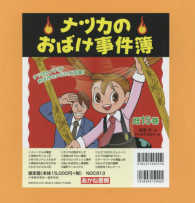Full Description
The Spanish Empire was a complex web of places and peoples. Through an expansive range of essays that look at Africa, the Americas, Asia, the Caribbean, and the Pacific, this volume brings a broad range of regions into conversation. The contributors focus on nuanced, comparative exploration of the processes and practices of creating, maintaining, and transforming cultural place making within pluralistic Spanish colonial communities.
The Global Spanish Empire argues that patterned variability is necessary in reconstructing Indigenous cultural persistence in colonial settings. The volume's eleven case studies include regions often neglected in the archaeology of Spanish colonialism. The time span under investigation is extensive as well, transcending the entirely of the Spanish Empire, from early impacts in West Africa to Texas during the 1800s. The contributors examine the making of a social place within a social or physical landscape. They discuss the appearance of hybrid material culture, the incorporation of foreign goods into local material traditions, the continuation of local traditions, and archaeological evidence of opportunistic social climbing. In some cases, these changes in material culture are ways to maintain aspects of traditional culture rather than signifiers of new cultural practices.
The Global Spanish Empire tackles broad questions about Indigenous cultural persistence, pluralism, and place making using a global comparative perspective grounded in the shared experience of Spanish colonialism.
Contents
List of Illustrations
Acknowledgments
Introduction: Place Making and Pluralism in the Global Spanish Empire
1. Contact, Colonialism, and the Fragments of Empire: Portugal, Spain, and the Iberian Moment in West Africa
2. Colonization, Transformations, and Indigenous Cultural Persistence in the Caribbean
3. Native American Responses to Spanish Contact and Colonialism in the American South
4. Pluralism and Persistence in the Colonial Sierra Sur of Oaxaca, Mexico
5. A Tense Convivencia: Place Making, Pluralism, and Violence in Early Spanish Central America
6. When the Saints Go Marching In: Religious Place Making during the Early Spanish Colonial Period in the Central Andes, 1532-1615
7. The People of Solomon: Performance in Cross-Cultural Contacts between Spanish and Melanesians in the Southwest Pacific, 1568 and 1595
8. Places, Landscapes, and Identity: Place Making in the Colonial Period Philippines
9. Colonial Surveillance, LÅnchos, and the Perpetuation of Intangible Cultural Heritage in Guam, Mariana Islands
10. Contested Geographies: Place-Making Strategies among the Indigenous Groups of South Texas and Northeastern Mexico
11. Importing Ethnicity, Creating Culture: Currents of Opportunity and Ethnogenesis along the Dagua River in Nueva Granada, ca. 1764
Contributors
Index
-

- 和書
- ヤクザと金融機関
-

- 電子書籍
- 愛馬エンゼル フラワーコミックスα






